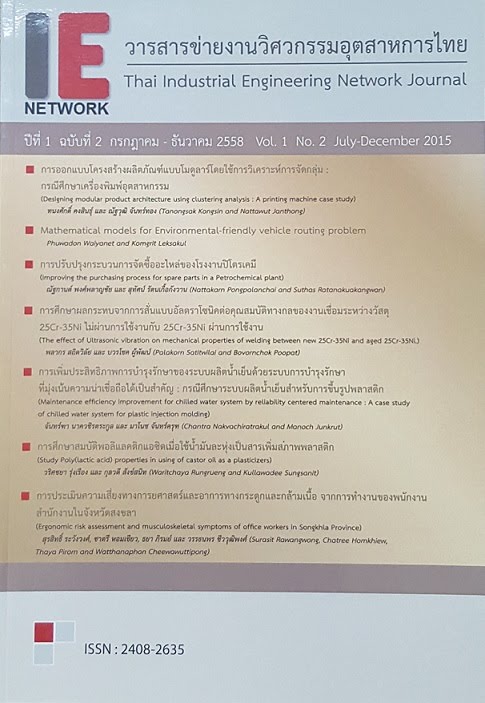Mathematical models for Environmental-Friendly’ Vehicle Routing Problem
Main Article Content
Abstract
Almost one third of all energy is used for road transportation and one important destructive environmental effect of fuel consumption in road transport is its contribution to atmospheric pollution. The amount fuel consumed and pollution emitted by a vehicle depends on its load, velocity and other factors. There are carbon balance between the total carbon in fuel and the total carbon in all of the combustion that are emitted to gas pollution. This paper presents a Mathematical models of Environmental-Friendly’ Vehicle Routing Problem or Fuel & Pollution-Routing Problem (FPRP), an extension of the classical Vehicle Routing Problem (VRP) with a wide and more all-inclusive objective function that accounts not only to minimizing the travel distance, but also minimizing for the amount of greenhouse gas emissions, fuel consumption, total travel times with stochastic velocity and time window, and then solved the problem by LINGO Programming on small-realistic instances. We obtained a reasonable result and also founded that it’s significantly more challenging to solve to optimality. Nevertheless, it had the potential of better yielding of reduction emission result than Classical Vehicle Routing Problem (VRP)
Article Details
บทความ ข้อมูล เนื้อหา รูปภาพ ฯลฯ ที่ได้รับการตีพิมพ์ในวารสารฯ ถือเป็นลิขสิทธิ์ของวารสารฯ หากบุคคลหรือหน่วยงานใดต้องการนำทั้งหมดหรือส่วนหนึ่งส่วนใดไปเผยแพร่ต่อหรือเพื่อกระทำการใดๆ จะได้รับอนุญาต แต่ห้ามนำไปใช้เพื่่อประโยชน์ทางธุรกิจ และห้ามดัดแปลง
References
[2]Bauer, J., Bektas_, T., Crainic, T.G., 2010. Minimizing greenhouse gas emissions in intermodal freight transport: an application to rail service design. Journal of the Operational Research Society 61 (3), 530–542.
[3]Barth, M., Boriboonsomsin, K., 2009. Energy and emissions impacts of a freeway-based dynamic eco-driving system. Transportation Research Part D 14 (6),
[4]Bodin, L., B.L. Golden, A. Assad and M.O. Ball, 1983. Routing and scheduling of the vehicle and crews: The state of the art. Comp. Operations Res., 10: 63-212.
[5]Cordeau, J.-F., Laporte, G., Savelsbergh, M.W.P., Vigo, D., 2007. Vehicle routing. In: Barnhart, C., Laporte, G. (Eds.), Transportation, Handbooks in Operations Research and Management Science, vol. 14. Elsevier, Amsterdam, The Netherlands, pp. 367–428 (Chapter 6).
[6]Dantzig, G. B. andRamser, J.H. 1959. “The Truck Dispatching Problem.” Management Science, Vol. 6.,80 -91.
[7]Hickman, J., Hassel, D., Joumard, R., Samaras, Z., Sorenson, S., 1999.Methodology for calculating transport emissions and energy consumption. Report No. SE/491/98. Transport Research Laboratory, Crowthorne, UK.
[8]Laporte, G., 1992. “The Vehicle Routing Problem: An overview of exact and approximate algorithms.” European Journal of Operational Research. Volume 59, 345-358.
[9]Li X., Tian P. and Leung S. C.H., 2010.“Vehicle routing problems with time windows and stochastic travel and service times: Models and algorithm.” Int. J. Production Economics 125, 137 - 145.
[10]Tarnchuda P., Kanok-orn R., and Ruengruaedee B., 2011.“Cost Reduction of VRP with Mathematic Model Case study: Ubon Aquar is Factory, Ubonratchathani”. Operation Research Network Conference 2011, 60-64.
[11]Xiao Y., Zhao Q., Kaku I. and Xu Y. (2012)."Development of a fuel consumption optimization model for the capacitated vehicle routing problem". Computers& Operations Research 39. pp. 1419 - 1431.
[12]Z. Zsigraiova et al. “Operation costs
and pollutant emissions reduction by definition of new collection scheduling and optimization of MSW GIS. The case study of Barreiro, Portugal”, Waste Management 33 (2013) 793–806.


